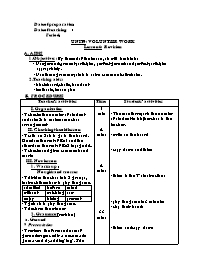Bài soạn môn học Tiếng Anh lớp 11 - Unit 4: Volunteer work - Lesson 6: Revision

A. AIMS
1. Objectives : By the end of the lesson, sts will be able to:
- Use gerunds, present participles, perfect gerunds and perfect participles appropriately.
- Use these grammar points to solve communicative tasks.
2. Teaching aids:
- blackboard, chalk, handouts
- textbook, lesson plan
B. PROCEDURES
Bạn đang xem tài liệu "Bài soạn môn học Tiếng Anh lớp 11 - Unit 4: Volunteer work - Lesson 6: Revision", để tải tài liệu gốc về máy bạn click vào nút DOWNLOAD ở trên
Date of preparation: Date of teaching : Period: Unit 4: volunteer work Lesson 6: Revision A. Aims 1. Objectives : By the end of the lesson, sts will be able to: - Use gerunds, present participles, perfect gerunds and perfect participles appropriately. - Use these grammar points to solve communicative tasks. 2. Teaching aids: - blackboard, chalk, handouts - textbook, lesson plan B. Procedures Teacher’s activities Time Students’ activities I. Organization - T checks the number of students and asks Ss to make some class arrangement. II. Checking the old lesson - T calls on 2 sts to go to the board. One does the rest of Ex1 and the other does the rest of Ex2 in page 54. - T checks and gives comments and marks III. New lesson 1. Warm- up : Noughts and crosses - T divides the class into 2 groups, instructs them how to play the game. admitted before mind without watching saw enjoy taking prevent - T gets sts to play the game. - T declares the winner 2. Grammar (revision) a. Gerund * Presentation - T reviews the form and uses of gerunds: A gerund is a noun made from a verd by adding “ing”. The gerund always has the same function as a noun, so it can be used. + As the subject of the sentence. Eg: Reading helps you learn E. + As the complement of “be” Eg: My hobby is playing game. + After prepositions. Eg: she is interested in learning E. + After phrasal verbs. Eg: He gave up smoking. + In compound nouns. Eg: a driving lesson, a fishing rod + After the expressions Can't stand, can't help,...... * Practice (Exercises below) b. Present participles * Presentation - T reviews the form and uses of present participles: The present participle of most verbs has the form V + ing and is used in the following ways: + As part of the continuous form. Eg: I am doing my homework. + After verbs of movement(V+Ving) Eg: She often goes swimming. + After verbs of perception. Eg: I heard him playing the piano. + As an adj. Eg: It was an interesting film. + To replace a sentence or part of a sentence. Eg: Putting on his coat, he left his house. * Practice (Exercises below) c. Present gerund * Presentation - T reviews the form and uses of present gerund: + Form: Having + PII + Use: instead of the present form of the gerund when we are referring to a past action/ or to emphasize completion in both the past and the future. Eg: He was accused of having stolen my car. I forgot having met you. * Practice (Exercises below) d. Perfect participle * Presentation - T reviews the form and uses of present participle: + Form: Having + PII + Use: instead of the present participle when one action is immediately followed by another with the same subject/ or to emphasize the first action is complete before the second one starts. Eg: - Having switching off the lights, he went to bed. - Having bought a bike, he cycled home. * Practice (Exercises below) IV. Consolidation - T summarises the main points of the lesson. V. Homework - T asks sts to do the extra exercises in the workbook. VI. Feedback 1. Good points 2. Weak points 1 min 4 mins 4 mins 33 mins 2 mins 1 min - The monitor reports the number of students in his/her class to the teacher. - write on the board - copy down and listen - listen to the T’s instructions - play the game in 3 minutes - clap their hands - listen and copy down - take note. - listen to T and copy down - listen and copy down - listen to T and copy down - take note - listen and copy down - listen to T and copy down - take note - take note - litsen - take note
Tài liệu đính kèm:
 Revision 4.doc
Revision 4.doc





